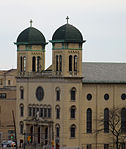Burke Avenue station
1917 establishments in New York CityIRT White Plains Road Line stationsNew York City Subway stations in the BronxNew York City Subway stations located abovegroundRailway stations in the United States opened in 1917 ... and 2 more
Use mdy dates from February 2019Williamsbridge, Bronx

The Burke Avenue station is a local station on the IRT White Plains Road Line of the New York City Subway. Located in the Bronx at the intersection of Burke Avenue and White Plains Road, it is served by the 2 train at all times and by the 5 train during rush hours in the peak direction.
Excerpt from the Wikipedia article Burke Avenue station (License: CC BY-SA 3.0, Authors, Images).Burke Avenue station
White Plains Road, New York The Bronx
Geographical coordinates (GPS) Address Nearby Places Show on map
Geographical coordinates (GPS)
| Latitude | Longitude |
|---|---|
| N 40.871 ° | E -73.867 ° |
Address
White Plains Road 3080
10467 New York, The Bronx
New York, United States
Open on Google Maps










